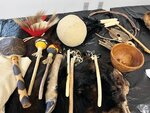

“To Canada, Wisconsin and Oklahoma,” according to a Newtown area woman, who added, “They are also spread out all over the country and living very modern lives.”
Christine Applegate, of the Museum of Indian Culture in Allentown, discussed the impact European settlers had on Northeastern Woodlands people when she addressed the Williams Township Historical Society.
“They had everything they needed before the Europeans arrived,” Applegate said, as she described their lifestyle. They also had peace. The white man changed all that.
One thing the settlers changed, she said, was the name: To the white man the indigenous people were no longer Lenapes but Delawares.
The Lenape lived mainly in small villages in the Delaware Valley on both banks of the river or along streams, and roamed west toward the Susquehanna Valley. These peaceful people, whose lives were so closely dependent on and rewarded by nature, were known as the grandfather tribe, settling disputes and generally dispensing wisdom to neighboring native communities.
Applegate displayed deerskin clothing and offered some surprising information about Lenape couture. Men, she said often wore no shirts. Their skin became acclimated to the weather but when it was very cold they would cover up with furs.
Their breechcloths, or loincloths, were always “as wide as the spread of your hand and as long as the man is tall,” Applegate said. The Lenape men often wore roach headdresses, made of porcupine quills and feathers, not the war bonnets usually associated with Plains Indians.
Lenape women wore a wrap-around skirt and a poncho with leggings up to their knees. Deerskin was usually fringed and that served two purposes. The fringe would help the clothes dry faster. Fringe also could be ripped off and eaten in time of famine.
The Lenape lived in wigwams made of a framework of saplings covered with bark. They were farmers, growing mostly corn, beans and squash. They used rakes made of deer antlers and hoes made from the shoulder blade of a moose. They used every part of the animals they hunted, Applegate explained.
That also was evident when it came to their music — drums and rattles made of turtle shells or deer hooves. Both men and women played flutes made of reed.
The Lenape were a matriarchal society. When a couple married, the man would move in with his wife’s family. The wife’s brothers would be expected to train her children. Children would learn to count using a bowl and pebbles.
Applegate noted, “Divorce was easy. The man would just pick up his tools and move out.
While the adults were primarily occupied with hunting and fishing, farming and food preparation, there were fun times, too, and games — a kind of football with men playing against the women, for example. In the summer they went to the shore, enjoying the ocean and collecting shells.
The beginning of the end came in 1524, Applegate said, when Italian explorer Giovanni Verrazzano, sailed up the Hudson and took Lenape prisoners. Peace reigned under William Penn and then came the Walking Purchase in 1737 and traders who bought fur and brought guns and disease to the natives. The French and Indian Wars followed and the Lenape were soon forced to leave their Pennsylvania paradise.
Applegate, who also is affiliated with the Lenape Village at the Churchville Nature Center, will present this program again on April 29 at 11 a.m. at the Riegelsville Public Library.
Kathryn Finegan Clark is a freelance writer who lives in Durham Township. She can be reached at kathyclark817@gmail.com.
Join our readers whose generous donations are making it possible for you to read our news coverage. Help keep local journalism alive and our community strong. Donate today.